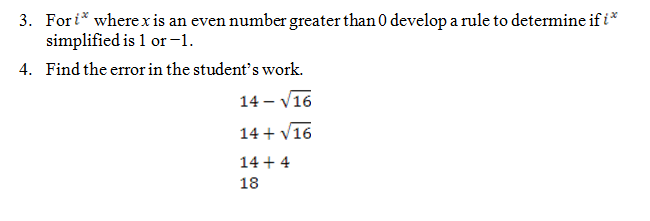
J We can handle calculations involving complex numbers in Excel with a few simple functions. Next, to calculate the current, I divide the voltage by the complex impedance using the function IMDIV.Ĭomplex numbers will always be…umm…complex, I guess. Operation involving square roots of negative numbers, square roots with variables equations, log base 2 calculation, Glencoe Mathematics Pre- Algebra cheat. In this case, I’ve used the suffix “j” to avoid confusion between the imaginary number “i” and the current “I”. Since the impedance is a complex number, I use the COMPLEX function in Excel. What is the current in the circuit?Īs you’ve seen, we can use Excel to handle the complex number calculations.įirst, I enter the input values for voltage and impedance. Suppose we have a circuit with a voltage of 12 volts and an impedance (Z) of 5+10j ohms. Let’s take a look at one of the calculations that Excel’s complex number functions enable: an RLC circuit. These functions enable many different engineering calculations in Excel, such as analyzing current in an RLC circuit or describing the motion of a damped harmonic oscillator. IMEXP, IMLN, IMLOG10, IMLOG2: Return the exponential, natural log, log (base 10) and log (base 2) of a complex number.IMSIN, IMCOS, IMTAN, etc.: Return the sine, cosine, tangent, etc.IMSUM, IMSUB, IMPRODUCT, IMDIV: Return the results of complex number addition, subtraction, multiplication, and division.

This is equivalent to the magnitude of the vector.

IMABS: Returns the absolute value of a complex number.But Microsoft includes many more useful functions for complex number calculations: If this is where Excel’s complex number capability stopped, it would be a huge disappointment. However, for most of us this can be omitted and the suffix will default to “i”.Īs an example, entering the following equation in Excel:Ĭonversely, the real and imaginary components of a complex number can be extracted using the IMREAL and IMAGINARY functions, respectively: You can use this optional argument to change the suffix from “i” to “j” if you wish. is the letter appended to the imaginary component of the complex number. I_num is the imaginary part of the complex number Real_num is the real part of the complex number The function is “ COMPLEX” and its syntax is as follows: The first, and most fundamental, complex number function in Excel converts two components (one real and one imaginary) into a single complex number represented as a+bi. Once turned on, these functions reside in the “Engineering” category of Excel functions. To gain access to them, first enable the Analysis Toolpak Add-In. Microsoft does not automatically expose the complex number functions in default Excel installations.

#Imaginary unit calculator how to
How to Enable Complex Number Calculations in Excel
#Imaginary unit calculator android
Except explicit open source licence (indicated Creative Commons / free), the "Complex Number Argument" algorithm, the applet or snippet (converter, solver, encryption / decryption, encoding / decoding, ciphering / deciphering, translator), or the "Complex Number Argument" functions (calculate, convert, solve, decrypt / encrypt, decipher / cipher, decode / encode, translate) written in any informatic language (Python, Java, PHP, C#, Javascript, Matlab, etc.) and all data download, script, or API access for "Complex Number Argument" are not public, same for offline use on PC, mobile, tablet, iPhone or Android app! Ask a new question Source codeĭCode retains ownership of the "Complex Number Argument" source code.

DCode always calculates the principal argument.


 0 kommentar(er)
0 kommentar(er)
